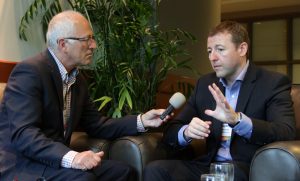By David Dodge & Dylan Thompson
What’s that old saying, a penny saved is a penny earned?
Nova Scotia really took this idea to heart in 2010 when it created Efficiency Nova Scotia (ENS). EfficiencyOne is the franchise holder of ENS and the first energy efficiency utility in Canada.
“Our only job is to save energy…We have performance targets, which are energy savings targets, which we must meet. If we do not meet those performance targets, it puts our franchise at risk,” says Stephen MacDonald CEO of EfficiencyOne.
Just like utilities that produce electricity, “We will make an application to our regulator, the Utility and Review Board, for how many gigawatt hours of electricity that we can deliver at what cost,” says MacDonald.
“Energy efficiency is acquired for about three cents a kilowatt hour,” says MacDonald. “Compare that in our jurisdiction to about 10 cents a kilowatt hour for wind energy.”
Unique in Canada

Efficiency Nova Scotia hosts Energy Efficiency Days at the Discovery Centre in Halifax to help youth understand and get involved in energy efficiency. Photo Efficiency NS
Often in traditional electricity markets you will see conventional utility companies contracted or required to deliver energy efficiency and energy conservation programs. But here’s the problem: utility companies make money when they sell energy. Asking these companies to spend money with the goal of encouraging lessened demand for their primary income source is loopy. It’s like contracting the local wolf to build your hen house.
The only thing EfficiencyOne does is save energy. And “In the regulatory framework, there is a cost-effectiveness test that’s applied to the programs.” This keeps the pressure on EfficiencyOne to produce the most savings at the lowest cost.
How effective is energy efficiency?
“If you think about Nova Scotia as being one big electricity bill, electricity costs are $110 million lower in 2016, than they otherwise would have been. So that’s about an 8 per cent reduction in our electricity load,” says MacDonald.
That’s $110 million saved every year. MacDonald says he expects greenhouse gas emissions to be “12 per cent lower than they otherwise would have been if not for energy efficiency.”
More than 225,000 Nova Scotians have participated in Nova’s Scotia’s energy efficiency programs to date. True to his word MacDonald says the cost of this energy was remarkably “a little less than three cents a kilowatt hour and that’s on a levelized basis.”
Energy efficiency from soup to nuts

EfficiencyOne helped GoodLeaf Farms invest in special LED lighting for their indoor horticultural grow-op for green leafy vegetables saving them $37,000 per year. Photo Efficiency NS
“We have rebates on more low-cost measures, like lighting. So LED lighting at a Home Depot, for example. But we also offer larger rebates on appliances,” says MacDonald.
Then they support high performance heat pumps, like the air-source heat pumps you see in net-zero homes.
EfficiencyOne will consult with homeowners, audit their homes and reward them when homeowners take measures that move the energy consumption needle.
“We have a new home construction program,” says MacDonald. “And if you’re building a new home, for example, we’ll offer incentives if you bring it to a certain efficiency level. We’re just about to launch a pilot in a couple weeks for a passive house pilot, and we’re trying to encourage the building community to look at passive house design as an option.”
A passive house is a big prize. One common definition is of a home 90 per cent more energy efficient than a conventional home.
Because EfficiencyOne is an independent, non-profit utility that is paid for results, this also means upgrading low-rent homes can be profitable, in terms of energy savings.
In 2014, EfficiencyOne upgraded the insulation or draft proofing of 160 low-rent apartments at no charge. This helped more than 6,000 low-income tenants save money.
Since 2011, the utility has supported the construction of 4,000 energy efficient homes. Over this same period, 5,500 low-income homeowners received upgrades to their homes that EfficiencyOne estimates saved them nearly $6 million dollars in 2015.
Since 2010, the utility has recycled more than 31,000 inefficient appliances. They did this by offering no-charge pick up and disposal of old “fridges, freezers and air conditioners.” Citizens that participate even receive a “small financial reward.”
The utility has also partnered with retailers such as Home Depot and Canadian Tire to offer in-store rebates on high efficiency LED light bulbs, programmable thermostats, power bars, etc.
Making business more competitive
The agency has energy specialists who develop custom programs with business and industry. One such project saved a client millions.
“We have energy specialists who will go in and work with the client to do a feasibility study of what might work best for them. We’ll negotiate with them an incentive, if they move forward with the project.”
Since 2010, the utility has helped more than 8,400 small businesses improve their energy efficiency. They estimate those businesses have saved nearly $10 million in 2015.
EfficiencyOne has also supported the construction of 13 commercial buildings “to a high efficiency standard.”
Only in Nova Scotia?

EfficiencyOne is Nova Scotia’s energy efficiency utility that secures energy savings for about three cents per kilowatt hour for Nova Scotians. Here CEO Stephen MacDonald is being interviewed by David Dodge of Green Energy Futures. Photo Nikki Way, GreenEnergyFutures.ca
“We’ve done studies about how much potential there is in Nova Scotia for energy efficiency, and using conservative estimates, through energy efficiency, the electricity load in the province can be reduced by at least 30% over the next 25-30 years,” says MacDonald.
Alberta is busy setting up its new Energy Efficiency Alberta agency to be funded by $542 million from carbon taxes. So are there lessons here for Alberta?
“At a high level, I think Alberta could adopt a model like Nova Scotia, and again that’s being a performance-based organization that’s independent of government and utilities,” says MacDonald. “It would have to work a little different in Alberta’s deregulated market, but the key things to do are pretty simple.”
Set clear targets and focus on building awareness of the organization and the brand is critical, says MacDonald. EfficiencyOne spends five to seven per cent of its budget on marketing, outreach and education and has customer satisfaction rates of about 90 per cent.
Saving $110,000,000 a year in Nova Scotia at a good price says it all.






